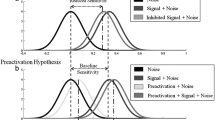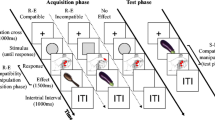Abstract
The ideomotor theory of action posits that the cognitive representation of an action includes the learned perceptual effects of the action. Support for this theory has come from studies demonstrating how perceptual features that match the outcome of a response can facilitate selection of that response. We investigated another, complementary implication of ideomotor theory: would a bias toward selecting a response result in a perceptual bias toward the known effect of the response? In other words, would an action tendency direct attention to the anticipated perceptual features? Through an initial acquisition phase, participants learned that two possible responses (left/right keypress) consistently produced two distinct colors. Next, in a test phase, we manipulated response bias at the beginning of each trial, using an uninformative spatial prime presented at the left or right periphery. We then examined the extent to which color transients that either matched or mismatched the induced response bias can orient participants’ visual attention. Results revealed a perceptual bias toward the color effect of the primed response, manifested in a stronger visual orienting toward this color. Thus, biasing response selection can bias perception. These findings extend the scope of the ideomotor theory to visual perceptual processes.



Similar content being viewed by others
Notes
Applying this outlier-exclusion criterion to the RT data did not affect the pattern of findings in either of the experiments.
We thank Ulrich Ansorge for suggesting this possibility.
References
Abrams, R. A., & Christ, S. E. (2003). Motion onset captures attention. Psychological Science, 14, 427–432.
Allport, A. (1993). Attention and control: Have we been asking the wrong questions? A critical review of twenty-five years. In D. E. Meyer & S. Kornblum (Eds.), Attention and performance XIV: Synergies in experimental psychology, artificial intelligence, and cognitive neuroscience (pp. 183–218). Cambridge, MA:MIT Press.
Ansorge, U. (2002). Spatial intention–response compatibility. Acta Psychologica, 109, 285–299.
Ansorge, U., & Wühr, P. (2004). A response-discrimination account of the Simon effect. Journal of Experimental Psychology: Human Perception and Performance, 30, 365–377.
Bekkering, H., & Neggers, S. F. W. (2002). Visual search is modulated by action intentions. Psychological Science, 13, 370–374.
Brainard, D. H. (1997). The Psychophysics Toolbox. Spatial Vision, 10, 433–436.
Brown, L. E., Moore, C. M., & Rosenbaum, D. A. (2002). Feature-specific perceptual processing dissociates action from recognition. Journal of Experimental Psychology: Human Perception and Performance, 28, 1330–1344.
Bundesen, C., Habekost, T., & Kyllingsbaek, S. (2005). A neural theory of visual attention: bridging cognition and neurophysiology. Psychological Review, 112, 291–328.
Cho, Y. S., & Proctor, R. W. (2003). Stimulus and response representations underlying orthogonal stimulus-response compatibility effects. Psychonomic Bulletin & Review, 10, 45–73.
Chun, M. M., Golomb, J. D., & Turk-Browne, N. B. (2011). A taxonomy of external and internal attention. Annual Review of Psychology, 62, 73–101.
Colzato, L. S., Warrens, M. J., & Hommel, B. (2006). Priming and binding in and across perception and action: a correlational analysis of the internal structure of event files. Quarterly Journal of Experimental Psychology, 59, 1785–1804.
Cousineau, D. (2007). Confidence intervals in within-subject designs: a simpler solution to Loftus and Masson’s method. Tutorials in Quantitative Methods for Psychology, 1, 42–45.
Craighero, L., Fadiga, L., Rizzolatti, G., & Umiltà, C. (1999). Action for perception: a motor-visual attention effect. Journal of Experimental Psychology: Human Perception and Performance, 25, 1673–1692.
Elsner, B., & Hommel, B. (2001). Effect of anticipation and action control. Journal of Experimental Psychology: Human Perception and Performance, 27, 229–240.
Folk, C. L., Remington, R. W., & Johnston, J. C. (1992). Involuntary covert orienting is contingent on attentional control settings. Journal of Experimental Psychology: Human Perception and Performance, 18, 1030–1044.
Fournier, L. R., Eriksen, C. W., & Bowd, C. (1998). Multiple-feature discrimination faster than single-feature discrimination within the same object. Perception & Psychophysics, 60, 1384–1405.
Gozli, D. G., & Pratt, J. (2011). Seeing while acting: hand movements can modulate attention capture by motion onset. Attention, Perception, & Psychophysics, 74, 2448–2456.
Gozli, D. G., & Pratt, J. (2012). Attentional repulsion effect despite a color-based control set. Visual Cognition, 20, 696–716.
Hommel, B. (1993). Inverting the Simon effect by intention: determinants of direction and extent of effects of irrelevant spatial information. Psychological Research, 55, 270–279.
Hommel, B. (1996). The cognitive representation of action: automatic integration of perceived action effects. Psychological Research, 59, 176–186.
Hommel, B. (1997). Toward an action-concept model of stimulus–response compatibility. In B. Hommel & W. Prinz (Eds.), Theoretical issues in stimulus–response compatibility (pp. 281–320). Amsterdam: North-Holland.
Hommel, B. (1998). Event files: evidence for automatic integration of stimulus – response episodes. Visual Cognition, 5, 183–216.
Hommel, B. (2004). Coloring an action: intending to produce color events eliminates the Stroop effect. Psychological Research, 68, 74–90.
Hommel, B. (2010). Grounding attention in action control: The intentional control of selection. In B. J. Bruya (Ed.), Effortless attention: a new perspective in the cognitive science of attention and action (pp. 121–140). Cambridge: MIT Press.
Hommel, B., & Colzato, L. S. (2004). Visual attention and the temporal dynamics of feature integration. Visual Cognition, 11, 483–521.
Hommel, B., Müsseler, J., Aschersleben, G., & Prinz, W. (2001). The Theory of Event Coding (TEC): a framework for perception and action planning. The Behavioral and Brain Sciences, 24, 849–878.
Hommel, B., & Schneider, W. X. (2002). Visual attention and manual response selection: distinct mechanisms operating on the same codes. Visual Cognition, 9, 392–420.
Itti, L., & Koch, C. (2001). Computational modelling of visual attention. Nature Reviews Neuroscience, 2, 194–203.
James, W. (1890).The Principles of Psychology: Vol. 2. New York, NY: Holt & Co.
Knudsen, E. I. (2007). Fundamental components of attention. Annual Review of Neuroscience, 30, 57–78.
Koch, I., & Kunde, W. (2002). Verbal response-effect compatibility. Memory & Cognition, 30, 1297–1303.
Kornblum, S., Hasbroucq, T., & Osman, A. (1990). Dimensional overlap: cognitive basis for stimulus-response compatibility – a model and taxonomy. Psychological Review, 97, 253–270.
Kunde, W. (2001). Response-effect compatibility in manual choice reaction tasks. Journal of Experimental Psychology: Human Perception and Performance, 27, 387–394.
Kunde, W., & Stöcker, C. (2002).A Simon effect for stimulus-response duration. The Quarterly Journal of Experimental Psychology, 55A, 581–592.
Kunde, W., & Wühr, P. (2004). Actions blind to conceptually overlapping stimuli. Psychological Research, 68, 199–207.
Logan, G. D. (1988). Toward an instance theory of automatization. Psychological Review, 95, 492–527.
Lu, C.-H., & Proctor, R. W. (1995). The influence of irrelevant location information on performance: a review of the Simon and spatial Stroop effects. Psychonomic Bulletin & Review, 2, 174–207.
Müsseler, J. (1999). How independent from action control is perception? An event-coding account for more equally-ranked crosstalks. In G. Aschersleben, T. Bachmann, & J. Müsseler (Eds.), Cognitive contributions to the perception of spatial and temporal events (advances in psychology) (Vol. 129, pp. 121–147). Amsterdam: Elsevier.
Müsseler, J., & Hommel, B. (1997). Blindness to response-compatible stimuli. Journal of Experimental Psychology: Human Perception and Performance, 23, 861–872.
Müsseler, J., Steininger, S., & Wühr, P. (2001). Can actions affect perceptual processing? Quarterly Journal of Experimental Psychology, 54A, 137–154.
Müsseler, J., Wühr, P., Danielmeier, C., & Zysset, S. (2005). Action-induced blindness with lateralized stimuli and responses. Experimental Brain Research, 160, 214–222.
Pelli, D. G. (1997). The video toolbox software for visual psychophysics: transforming numbers into movies. Spatial Vision, 10, 437–442.
Pomerantz, J. R., & Portillo, M. C. (2011). Grouping and emergent features in vision: Toward a theory of basic gestalts. Journal of Experimental Psychology: Human Perception and Performance, 37, 1331–1349.
Posner, M. I. (1980). Orienting of attention. Quarterly Journal of Experimental Psychology, 32, 3–25.
Posner, M. I., & Cohen, Y. (1984). Components of visual orienting. Attention and Performance X: Control of language Processes, 32, 531–556.
Prinz, W. (1990). A common coding approach to perception and action. In O. Neumann & W. Prinz (Eds.), Relationships between Perception and Action (pp. 167–201). New York, NY: Springer.
Prinz, W. (1997). Perception and action planning. European Journal of Cognitive Psychology, 9, 129–154.
Proctor, R. W., & Cho, Y. S. (2006). Polarity correspondence: A general principle for performance of speeded binary classification tasks. Psychological Bulletin, 132, 416–442.
Remington, R. W., & Folk, C. L. (2001). A dissociation between attention and selection. Psychological Science, 12, 511–515.
Schubö, A., Aschersleben, G., & Prinz, W. (2001). Interactions between perception and action in a reaction task with overlapping S-R assignments. Psychological Research, 65, 145–157.
Schubö, A., Prinz, W., & Aschersleben, G. (2004). Perceiving while acting: Action affects perception. Psychological Research, 68, 208–215.
Schütz-Bosbach, S., & Prinz, W. (2007). Perceptual resonance: action-induced modulation of perception. Trends in Cognitive Sciences, 11, 349–355.
Shin, Y. K., Proctor, R. W., & Capaldi, E. J. (2010). A review of contemporary ideomotor theory. Psychological Bulletin, 136, 943–974.
Stock, A., & Stock, C. (2004). A short history of ideo-motor action. Psychological Research, 68, 176–188.
Stoet, G., & Hommel, B. (1999). Action planning and the temporal binding of response codes. Journal of Experimental Psychology: Human Perception and Performance, 25, 1625–1640.
Theeuwes, J. (2010). Top-down and bottom-up control of visual selection. Acta Psychologica, 135, 77–99.
Theeuwes, J., Atchley, P., & Kramer, A. F. (2000). On the time course of top-down and bottom-up control of visual attention. In S. Monsell & J. Driver (Eds.), Control of cognitive processes: Attention and performance XVIII (pp. 105–124). Cambridge, MA: MIT Press.
Thomaschke, R., Hopkins, B., & Miall, R. C. (2012a). The planning and control model (PCM) of motorvisual priming: Reconciling motorvisual impairment and facilitation effects. Psychological Review, 119, 388–407.
Thomaschke, R., Hopkins, B., & Miall, R. C. (2012b). The role of cue-response mapping in motorvisual impairment and facilitation: Evidence for different roles of action planning and action control in motorvisual dual-task priming. Journal of Experimental Psychology: Human Perception and Performance, 38, 336–349.
Treisman, A., & Sato, S. (1990). Conjunction search revisited. Journal of Experimental Psychology: Human Perception and Performance, 16, 459–478.
Treisman, A., & Schmidt, H. (1982). Illusory conjunctions in the perception of objects. Cognitive Psychology, 14, 107–141.
Von Mühlenen, A., Rempel, M. I., & Enns, J. T. (2005). Unique temporal change is the key to attentional capture. Psychological Science, 16, 979–986.
Wühr, P., & Müsseler, J. (2001). Time course of the blindness to response-compatible stimuli. Journal of Experimental Psychology: Human Perception and Performance, 27, 1260–1270.
Wykowska, A., Schubö, A., & Hommel, B. (2009). How you move is what you see: action planning biases selection in visual search. Journal of Experimental Psychology: Human Perception and Performance, 35, 1755–1769.
Yantis, S. (2000). Goal-directed and stimulus-driven determinants of attentional control. In S. Monsell & J. Driver (Eds.), Attention and Performance (Vol 18, pp. 73–103). Cambridge, MA: MIT Press.
Yantis, S., & Egeth, H. E. (1999). On the distinction between visual salience and stimulus-driven attentional capture. Journal of Experimental Psychology: Human Perception and Performance, 25, 661–676.
Ziessler, M. (1998). Response-effect learning as a major component of implicit serial learning. Journal of Experimental Psychology: Learning, Memory, and Cognition, 24, 962–978.
Zwickel, J., Grosjean, M., & Prinz, W. (2007). Seeing while moving: measuring the online influence of action on perception. Quarterly Journal of Experimental Psychology, 60, 1063–1071.
Zwickel, J., Grosjean, M., & Prinz, W. (2010). On interference effects in concurrent perception and action. Psychological Research, 74, 152–171.
Zwickel, J., & Prinz, W. (2012). Assimilation and contrast: The two sides of specific interference between action and perception. Psychological Research, 76, 171–182.
Acknowledgments
This study was supported by a discovery grant from the Natural Sciences and Engineering Research Council of Canada (NSERC) to JP, an NSERC postgraduate scholarship awarded to DGG, and an Ontario Government Postdoctoral Fellowship to SCG.
Author information
Authors and Affiliations
Corresponding author
Rights and permissions
About this article
Cite this article
Gozli, D.G., Goodhew, S.C., Moskowitz, J.B. et al. Ideomotor perception modulates visuospatial cueing. Psychological Research 77, 528–539 (2013). https://doi.org/10.1007/s00426-012-0461-9
Received:
Accepted:
Published:
Issue Date:
DOI: https://doi.org/10.1007/s00426-012-0461-9




